
Customer Carol asks:
I have been using a Paul Revere tea kettle every day for over 25 years. Is it still safe to use or does the inside corrode?

Customer Carol asks:
I have been using a Paul Revere tea kettle every day for over 25 years. Is it still safe to use or does the inside corrode?

Just a reminder to our customers or potential customers that we do our best to provide good customer service.
If a product arrives damaged, we will replace it.
If a shipment fails to arrive, we will ask that you work with the Postal Service to locate it, and it that doesn’t work, we will replace it.
If a part fails and you weren’t abusing it, we will replace it.
If you are having an issue installing or using one of our parts, we will do our best to help you, and if that doesn’t work, we will take it back for a refund.
If you have a question, even one that isn’t related to one of our parts or won’t result in a sale, we will do our best to answer it. However, we do shy away from giving marital advice.
The only thing we ask is that you give us a chance to solve your problem before giving up (and leaving us negative feedback), and that you are kind in your communications.
I wish more people who purchase products online would expect good customer service (and hold businesses accountable when they don’t provide it). If everyone did that, businesses that didn’t provide good customer service would not survive.
We often get queries for replacement parts not in our catalog. Unfortunately, it isn’t economical for us to supply every type of part regardless of the amount of demand out there for it. One option, is to search eBay for new old stock replacement parts.
When that doesn’t work, it isn’t necessarily the end. Given that there is a very rich marketplace on eBay for Revere Ware cookware, you can very likely find the same piece you are looking for a part for, that is complete, and use it as a donor for the parts you need.
One example of a part that is critical and can no longer be purchased anywhere is the over pressure plug for the vintage pressure cooker.
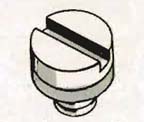
While this may look like a simple screw, it is not. IT has a hole in the center filled with solder that will blow out at high pressure. Once the over pressure plug has been blown out, it must be replaced.
eBay typically has quite a few listings for the vintage pressure cooker. For example, here is one for $30 shipped.
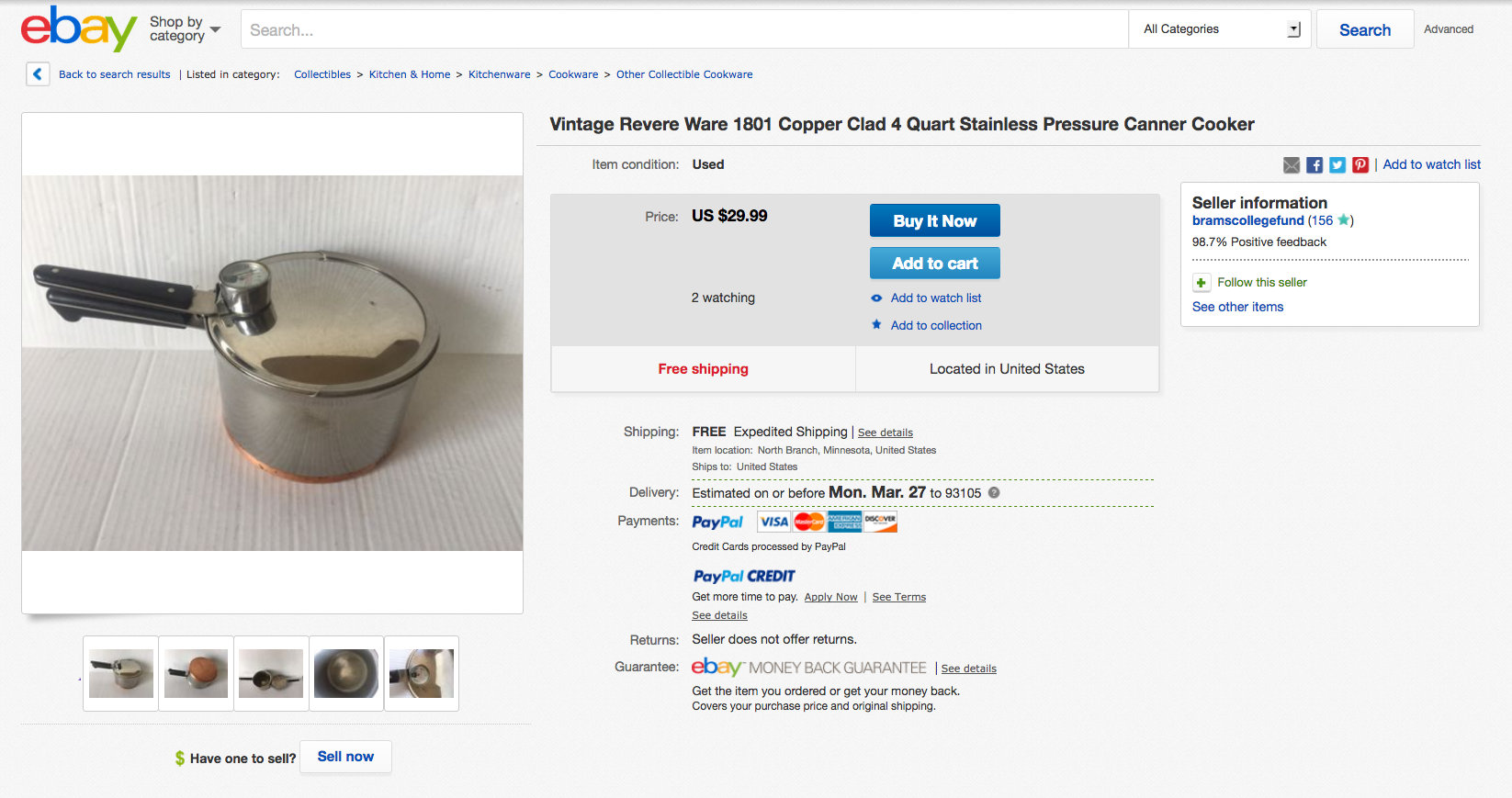
If you are attached to your vintage piece (as many of us are) this probably isn’t too much to pay to get your pressure cooker functional again, and you’ll get some other extra parts to boot.
So, the next time you can’t find a replacement part, consider buying a used piece as a parts donor.
If you’ve got some serious crud on your Revere Ware, see our cleaning guide for some good tips on how to clean them up.
Here is what we used for ongoing maintenance of our Revere Ware.
First, never put your Revere Ware with Bakelite handles in the dishwasher or oven. The oven can damage Bakelite; even though Bakelite is considered safe up to 350 degrees F, modern ovens can reach higher temperatures in places even when they are set for this maximum temperature. We’ve heard many complaints to this effect. Oven use will invalidate our generous replacement policy on manufacturing defects.
Dishwasher use can dull Bakelite over time (see our dishwasher test) and is not recommended.
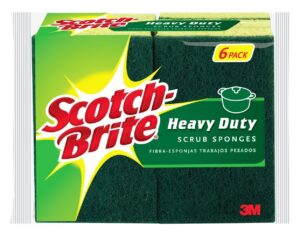
We often use Scotch Brite pads to clean the inside of the cookware only. While it will dull stainless steel, the inside of cookware becomes naturally dulled because of metal utensils, so this won’t matter. Scotch Brite pads do a good job of removing cooked on items, and hard water buildup for pots that are used to boil water.
Don’t use these pads on the outside of your cookware, which you want to remain polished.
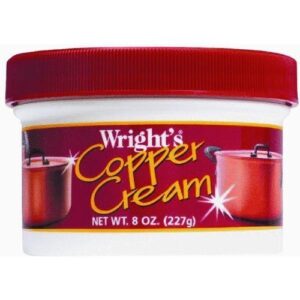
For the copper bottom, we use Wright’s Copper Cream. It is the closest we’ve found to the original copper paste offered by Revere Ware, and is more readily available.
There are many other natural methods of polishing copper (like baking soda, lemon juice, or ketchup) but we get faster and better results with the copper cream.
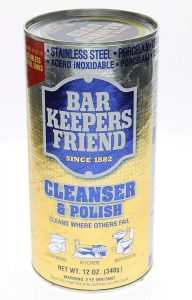
For polishing the stainless steel on the outside of the cookware, we use Bar Keepers Friend. While it won’t necessarily make your cookware look like new, it will add a little shine.
We also like to occasionally use Bar Keepers Friend on the inside. It won’t make the dulled interior polished again, but, it does seem to smooth the stainless steel out a bit and make food stick less.
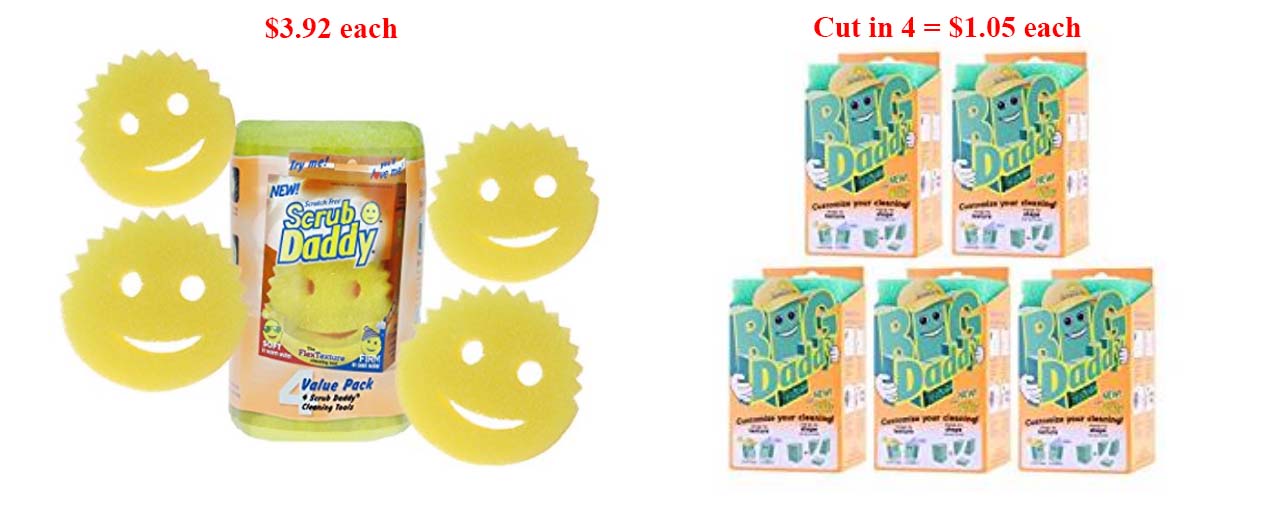
A few years ago I discovered the Scrub Daddy sponges. They are nicely abrasive without scratching the polished stainless steel on the outside of my Revere Ware pans.
The problem is, they are expensive at almost $4 per sponge, and they start falling apart after a couple of weeks of use. That’s $100 of sponges a year, or about a Spotify subscription.
I recently discovered that the company makes another type of sponge out of the same material – the Big Daddy sponge, which is a giant block. Now, I slice that block into four pieces, which end up just a tad smaller than the Scrub Daddy smiley face sponges; this brings the cost down to about a buck a sponge.
We get a lot of request for parts that we don’t carry – unfortunately, parts for some less popular pieces just don’t have enough volume to justify a production run complete with customer part molds.
One of the most of-requested parts is the trigger for the 3-quart Revere Ware tea kettle. We’ve talked about 3D-printing them, but unfortunately materials aren’t quite to the point yet where they can handle the high temperatures that cookware require.
For the determined and dilligent, let me introduce you to a new concept – new old stock, which is often shortened in product listings to NOS. New old stock stands for an item that is no longer in production, but someone found a cache of them somewhere that are still brand new.
For the tea kettle example, here is a small cache of the (get them while you can, they will go quick), at an incredibly reasonable price.
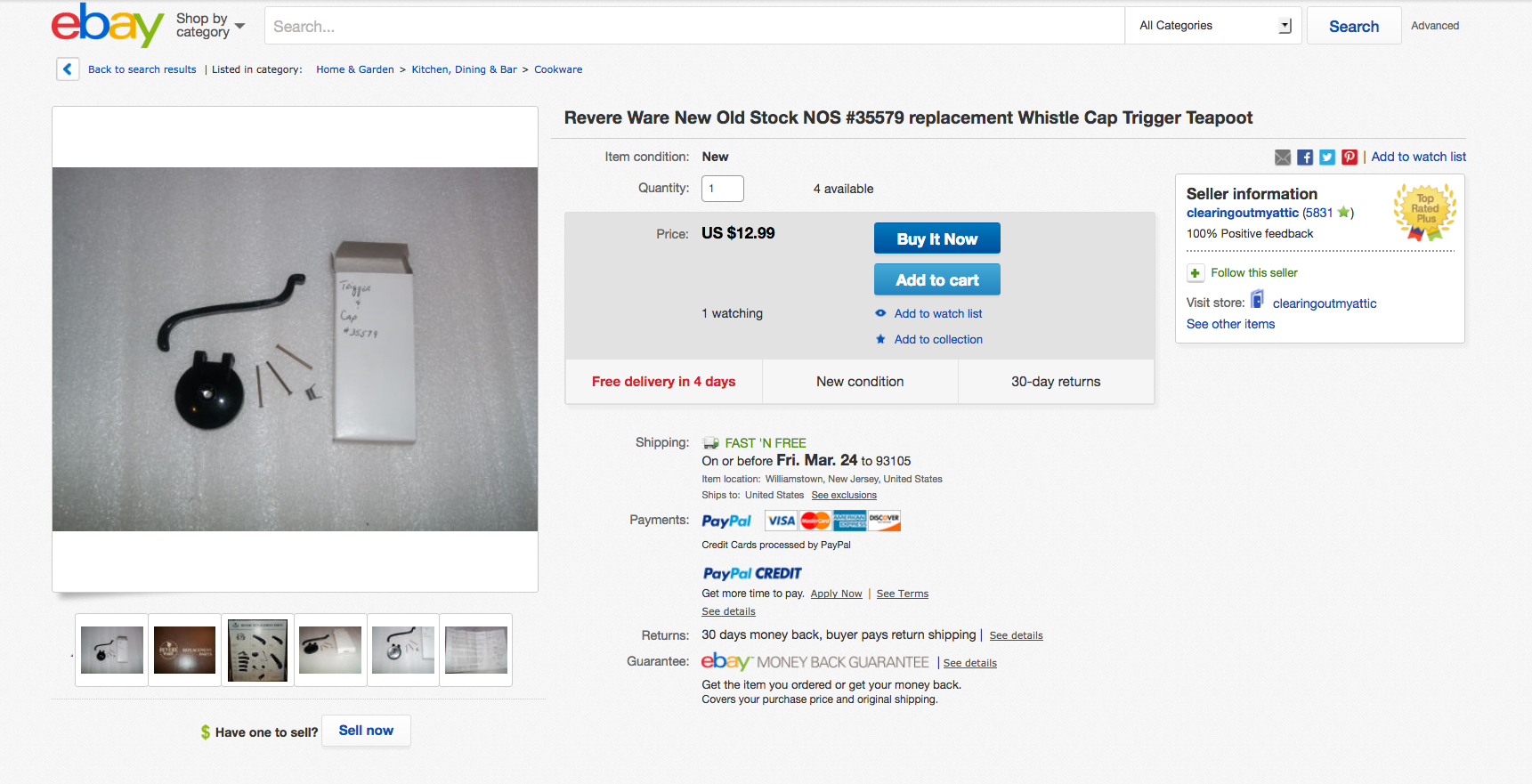
Over the years, we’ve seen just about every part we’ve needed eventually show up on eBay, and this is how we got most of the samples we’ve used for our production runs. Here is another part people often ask us about, the percolator and coffee pot handle.
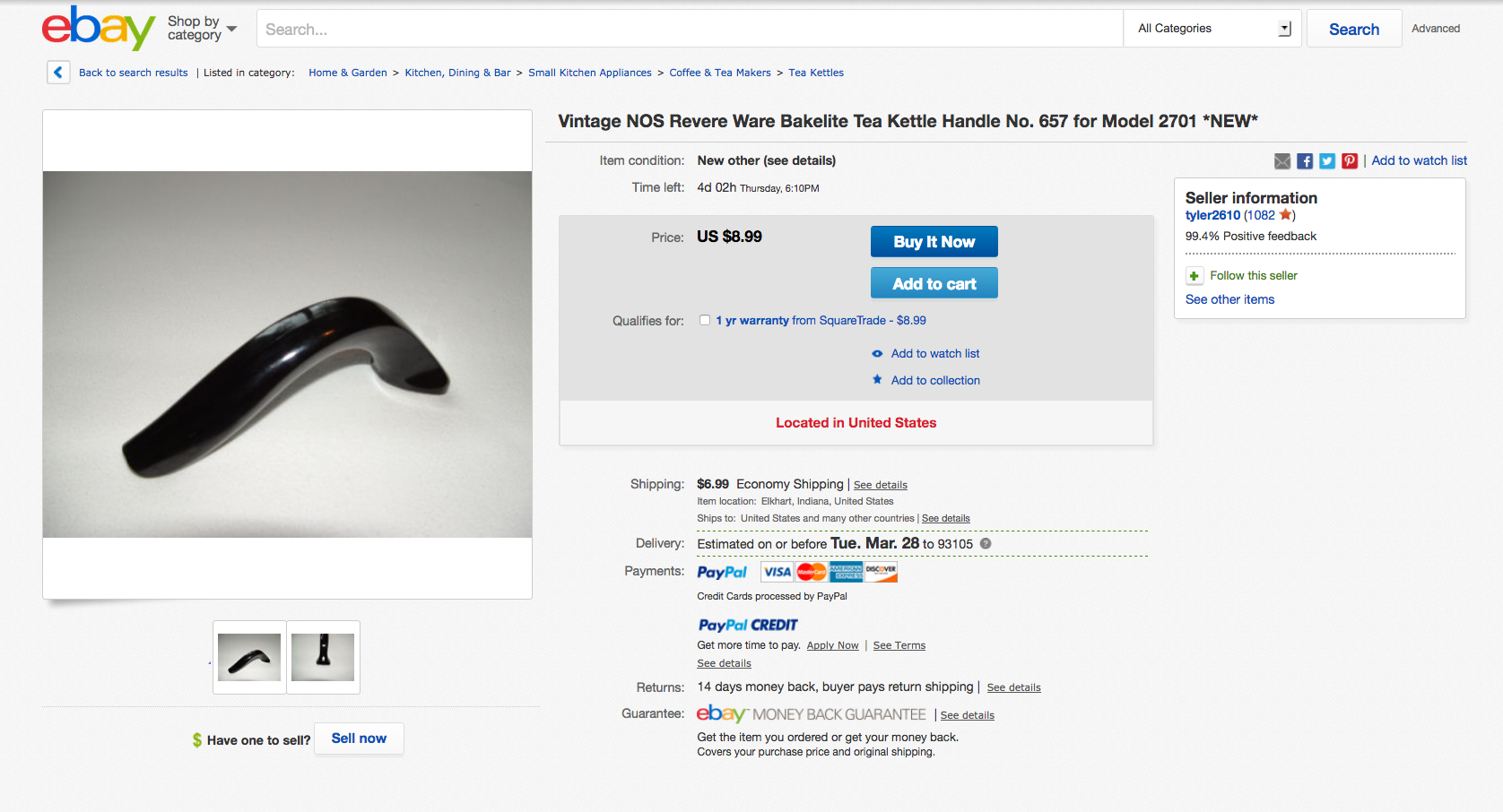
If you are looking for a replacement part, search for it on eBay. If you don’t find it, try saving the search via the follow this search link in the top of the search results, so that when new matches occur, you’ll get an email.
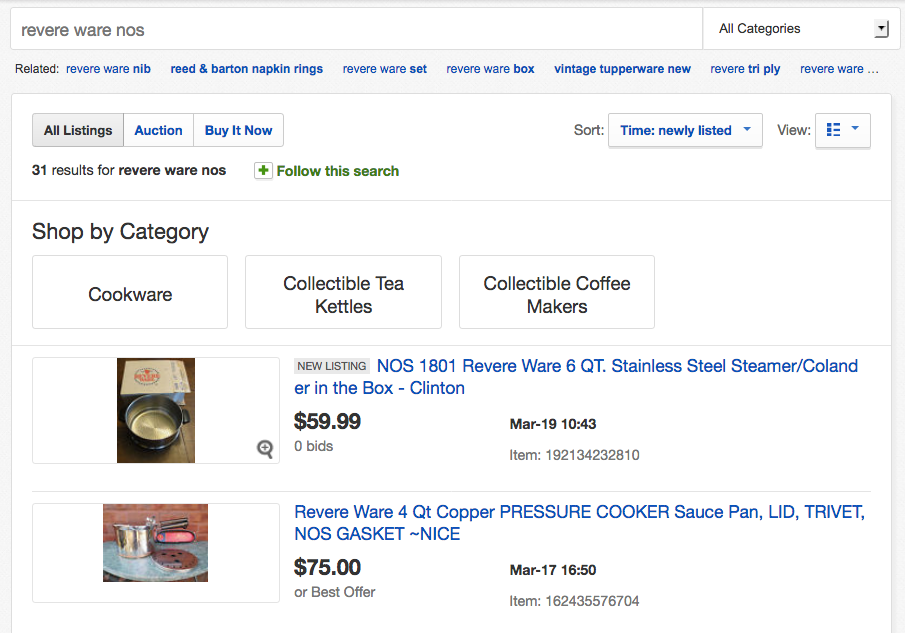
The search above, for “Revere Ware NOS” is a good place to start if you are looking for replacement parts that we don’t carry.
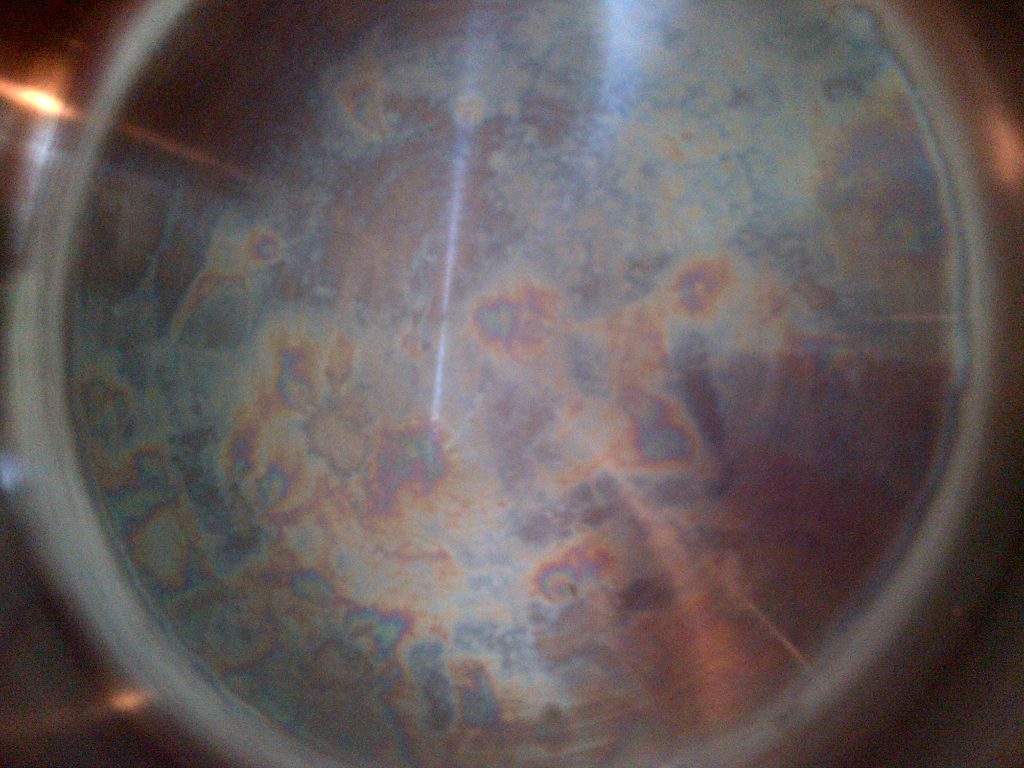
If you’ve ever overheated your stainless steel cookware (like almost all Revere Ware) you’ve seen that rainbow tint discoloration that stainless steel can take on. This isn’t something you can simply wash off. This discoloration is called heat tint.
Stainless steel works (keep from rusting) due to the addition of small amount of chromium int the steel mixture. (Note that this is a type of chromium that the body needs in trace amounts, not the hexavalent chromium of the type featured in the move Erin Brockovich.) The Chromium oxidizes and forms a thin layout on the outside of the stainless steel which keeps the iron from rusting. The nice thing about stainless steel is that this layer is self repairing; if you damage it, more chromium is exposed to air and oxidizes to form a new protective layer.
However, it seems that under high heat, parts of the stainless steel can form a thicker chrome oxide layer. Chrome oxide layers of different thicknesses will show different colors.
In short, the rainbow tint is completely harmless, if not annoying. The best suggestion we’ve seen to remove it is to use a stainless steel cleaner like Bar Keepers Friend to polish the outside of the cookware.
We offer plenty of cleaning tips, but unless you are obsessed with cleaning your cookware, inevitably over the years it will look like ours did, with lots of crud stuck in the nooks and crannies around the outside of pots and pans, black burnt on spots on the copper bottom that just won’t come off, and lots of deep scratches that no amount of Bar Keeper’s Friend can get out.
Now you have a new option for complete restoration. Classic Kitchens & More offers a restoration service that (along with our replacement parts) will have your Revere Ware looking almost like the day it was made.
Some close-ups show the amazing difference even better.
The results are pretty close to perfect; there are still a few “love” marks in the cookware from deeper scratches and some deeper pits on he inside (most likely from acidic foods or someone used oven cleaner to clean out some burnt on food). I prefer them this way so they retain a little bit of their history.
Please contact Classic Kitchens and More (www.classickitchensandmore.com) for a quote. Note that they can also do small repairs where the handle comes away from the pot/pan, as long as it hasn’t separated in such a way as to leave a hole.
Update: Unfortunately we can no longer recommend Classic Kitchens and More. We helped them some years back with the production of some coffee maker cords, and, after they received the items (perhaps we were too trusting) they failed to pay us the thousands of dollars we paid on their behalf.
Sometimes, handles that have been in use for years can be very difficult to get off so you can replace them with new ones. Frequently, screws and nuts will rust together, making them impossible to get apart (the nut simply spins). Take this one for example. Years of grease make even the handles reluctant to separate.
Unfortunately, in this case I had to break apart the handle to expose the screws so I could twist them apart, and the screws themselves broke off rather than unscrew.
In this case, I used a screwdriver to pry the handle halves apart until one of them broke off. I tried prying the rest of the Bakelite off, but the handle spline started to deform. So I placed the handle against a hard surface (concrete) and repeatedly hit it with a hammer until all the Bakelite was off. Then I used two pairs of pliers to try to unscrew the screws, which broke off.
Sometimes it simply isn’t possible to save the old handle or hardware when removing them.
Customer Jim sent us these pictures of his destroyed try-ply cookware. It offers a cautionary tale of using too high of a heat and/or leaving your cookware unattended.
We’ve shown before that even for copper bottom cookware, it is unwise to heat the pans for an extended period of time as it can damage the copper layer.
If you do overheat your cookware, LET IT COOL SLOWLY BY ITSELF. If you douse a hot piece of cookware with cold water, it will almost certainly warp the bottom and it won’t sit flat any longer.
